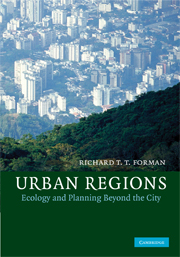Book contents
- Frontmatter
- Contents
- Foreword
- Foreword
- Preface
- Acknowledgments
- 1 Regions and land mosaics
- 2 Planning land
- 3 Economic dimensions and socio-cultural patterns
- 4 Natural systems and greenspaces
- 5 Thirty-eight urban regions
- 6 Nature, food, and water
- 7 Built systems, built areas, and whole regions
- 8 Urbanization models and the regions
- 9 Basic principles for molding land mosaics
- 10 The Barcelona Region's land mosaic
- 11 Gathering the pieces
- 12 Big pictures
- Appendices
- References
- Index
- Plate section
7 - Built systems, built areas, and whole regions
Published online by Cambridge University Press: 04 August 2010
- Frontmatter
- Contents
- Foreword
- Foreword
- Preface
- Acknowledgments
- 1 Regions and land mosaics
- 2 Planning land
- 3 Economic dimensions and socio-cultural patterns
- 4 Natural systems and greenspaces
- 5 Thirty-eight urban regions
- 6 Nature, food, and water
- 7 Built systems, built areas, and whole regions
- 8 Urbanization models and the regions
- 9 Basic principles for molding land mosaics
- 10 The Barcelona Region's land mosaic
- 11 Gathering the pieces
- 12 Big pictures
- Appendices
- References
- Index
- Plate section
Summary
Following the preceding chapter on nature, food and water, perhaps surprisingly we now turn to built areas to learn about natural systems and their human uses in an urban region. Consider two diplomats attempting to negotiate a treaty. If wise, each spends considerable time in advance learning about the other's perspectives and concerns. With those dual insights, agreement is more likely and the product should be more solidly constructed. In the present case, we must understand nature in built areas, and how built systems and built areas affect their surroundings.
Built systems are basically for the transport of people and goods. Radial highways, ring highways, commuter-rail lines, airports, shipping/ferry ports, and transportation corridors to ports and airports in urban regions are the emphasis here. In contrast, built areas are mainly for locating people and their activities on land. Here we focus on the metropolitan area, satellite cities, towns, certain small sites, strip development, and adjacent land covers. Evidence of regional planning is also highlighted.
Several attributes relate to whole urban regions. Those presented include the context of the metropolitan area, border lengths of various built-area types, other major political/administrative units in the region, and the effect of other major cities surrounding an urban region.
Interactions of an urban region with other regions, especially the surrounding regions, are usually quite significant. Effects may cover essentially the whole urban region, the metro area or city, a particular land-cover type, or specific sites or types of sites.
- Type
- Chapter
- Information
- Urban RegionsEcology and Planning Beyond the City, pp. 164 - 197Publisher: Cambridge University PressPrint publication year: 2008



